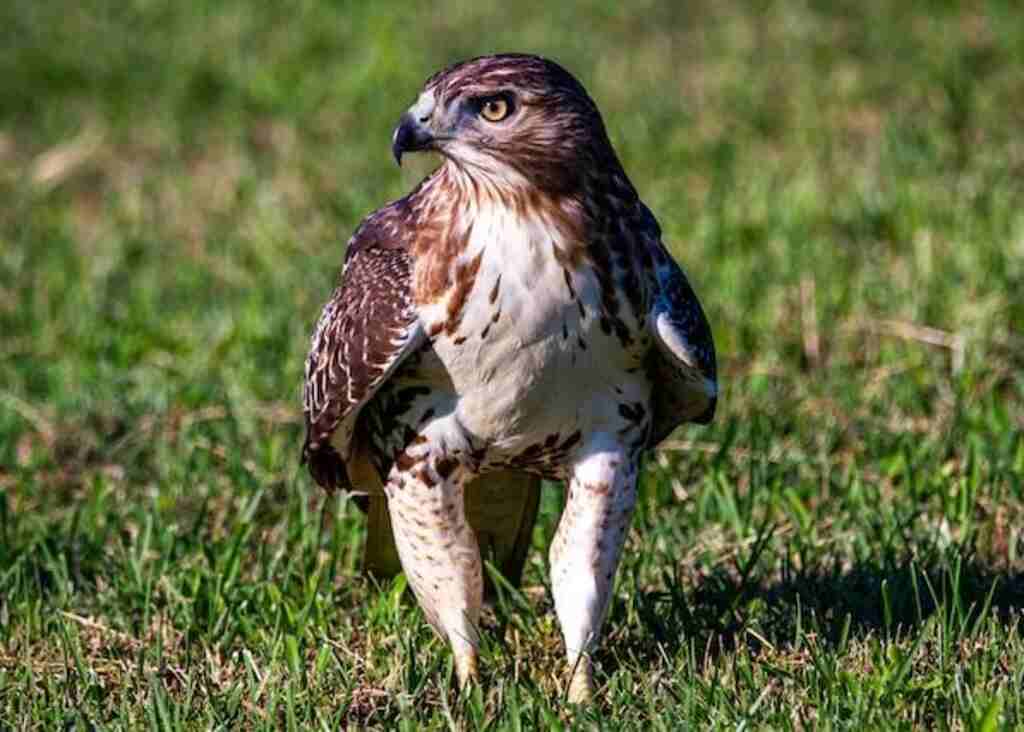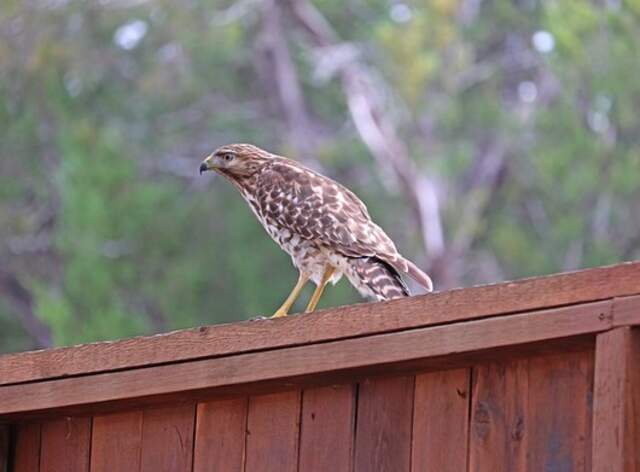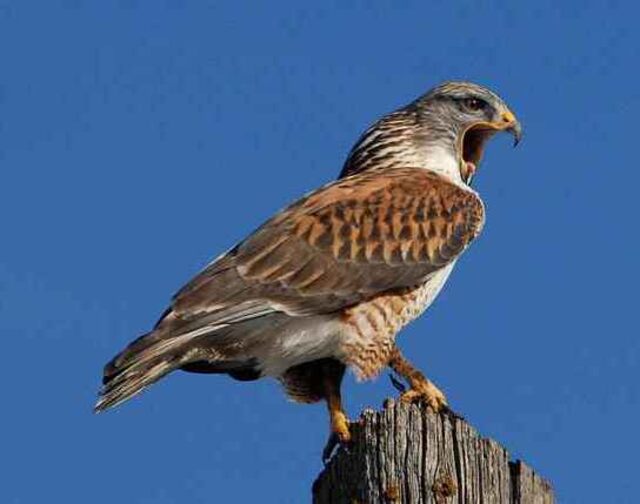Have you ever wondered are hawks protected by law?
As a lover of freedom and the natural world, it’s important to understand the laws and regulations in place to protect these majestic birds of prey.
Hawks play a crucial role in our ecosystem, and their presence is a sign of a healthy environment.
The protection of hawks is governed by a variety of federal and state laws, including the Migratory Bird Treaty Act of 1918.
These laws help to regulate the hunting, possession, and transportation of hawks, and provide penalties for those who violate them.
But the protection of hawks goes beyond legal regulations, as rehabilitation and release programs and citizen science initiatives also play a vital role in ensuring the survival of these magnificent birds.
In this article, we will explore the laws and regulations in place to protect hawks, the threats facing their populations, and the importance of their conservation and preservation.
Table of Contents
- 1 Are Hawks Protected?
- 2 Overview of Hawks and Their Importance in the Ecosystem
- 3 The Migratory Bird Treaty Act of 1918
- 4 Other Federal and State Laws Protecting Hawks
- 5 Penalties for Violating Hawk Protections
- 6 Hawk Rehabilitation and Release Programs
- 7 The Role of Citizen Science in Hawk Conservation
- 8 Threats to Hawk Populations
- 9 The Importance of Hawk Conservation and Preservation
- 10 Frequently Asked Questions
- 11 Conclusion
- 12 Author
Are Hawks Protected?
Yes, hawks are protected by various laws and regulations in many countries. In the United States, for example, hawks are protected under the Migratory Bird Treaty Act and the Bald and Golden Eagle Protection Act.
These laws prohibit the capture, killing, or disturbance of hawks, their nests, or their eggs without proper permits.
Hawks are also protected in several other countries to ensure their conservation and prevent their decline due to habitat loss and illegal activities.
It is important to respect these protections and appreciate the vital role hawks play in ecosystems as apex predators.
Overview of Hawks and Their Importance in the Ecosystem
You’re probably familiar with the way ecosystems work, but did you know that there’s one creature that plays a crucial role in maintaining balance?
Hawks are one of the most important species in the food chain, as they are apex predators that keep other populations in check.
They are known for their impressive hunting techniques, such as their keen eyesight, powerful talons, and swift speed.
Hawks have a unique behavior that allows them to work together in pairs or groups to catch their prey.
They are also known for their migration patterns, as they travel hundreds or even thousands of miles to find food and suitable habitats.
Hawks are not only important for maintaining balance in the ecosystem, but they are also a symbol of freedom and strength.
It’s no wonder that they’re protected by the migratory bird treaty act of 1918, which prohibits the hunting, killing, or capturing of migratory birds, including hawks, without a permit.
This law has helped to ensure the survival of these majestic birds for generations to come.
The Migratory Bird Treaty Act of 1918
The Migratory Bird Treaty Act, passed in 1918, provides legal protection for a wide variety of bird species, including hawks. This act is a federal law that was created to protect migratory bird populations from hunting and other harmful activities.
Under this act, it’s illegal to hunt, capture, kill, sell, or transport migratory birds without a valid permit. In addition, the act regulates hunting regulations for migratory bird species, including hawks.
The act has been successful in protecting migratory bird populations, including hawks, from human-induced threats.
As an audience that has a subconscious desire for freedom, it’s important to know that these regulations are in place to ensure that our ecosystems remain healthy and balanced.
Other federal and state laws protecting hawks also exist to help regulate and protect these important birds.
Other Federal and State Laws Protecting Hawks
Oh, so you wanna know about other laws that keep those majestic creatures with the sharp talons and piercing eyes safe? Boy, do I have news for you.
Along with the Migratory Bird Treaty Act of 1918, there are other federal and state laws in place to protect hawks.
For example, the Bald and Golden Eagle Protection Act of 1940 safeguards not only eagles, but also other birds of prey, including hawks.
Additionally, the Endangered Species Act of 1973 offers protection to certain hawk species, such as the Hawaiian hawk and the northern goshawk.
These laws recognize hawks as symbols of strength and freedom and help maintain their populations for the enjoyment of hawk watching tourism.
Violating these laws can result in serious penalties, which we’ll discuss in the next section.
Penalties for Violating Hawk Protections
If you harm these magnificent creatures, you’ll be facing severe penalties that will make you regret ever thinking of breaking the law.
Legal consequences for violating hawk protections can include hefty fines, imprisonment, and even the loss of hunting privileges.
The penalties vary depending on the severity of the offense and the type of hawk involved.
Additionally, if you find an injured or orphaned hawk, it’s important to remember that it’s illegal to keep them without proper permits and training.
Instead, contact a licensed wildlife rehabilitation center to ensure the hawk receives proper care and has the best chance of survival.
By respecting the laws protecting these birds, you can help preserve their populations and contribute to the success of hawk rehabilitation and release programs.
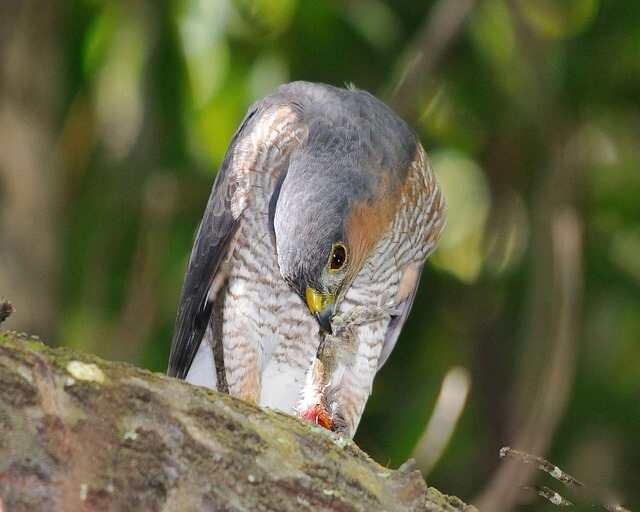
Hawk Rehabilitation and Release Programs
You can learn about how injured or orphaned birds of prey are rehabilitated and released back into the wild by visiting a local animal rehabilitation center. For example, a baby hawk was recently nursed back to health after falling out of its nest.
Hawk rehabilitation programs are essential for the survival of these magnificent birds. These programs involve a range of release strategies that ensure their successful reintegration into their natural habitat.
They are typically run by experienced wildlife rehabilitators who provide specialized care and treatment, including medical attention, nutrition, and behavioral rehabilitation.
Once the hawks are deemed fit for release, they are often taken to a suitable location where they can thrive in the wild.
The rehabilitation and release of hawks are critical for maintaining healthy populations. It is an excellent way for people to get involved in conservation efforts.
Citizen science plays a vital role in monitoring hawk populations. We will explore this further in the next section.
The Role of Citizen Science in Hawk Conservation
The importance of citizen involvement in conserving and monitoring hawk populations cannot be overstated.
Citizen science programs provide an opportunity for individuals to help collect data on these majestic birds of prey, allowing researchers to better understand their behavior and habitat needs.
By participating in these programs, volunteers can contribute to the protection and conservation of hawks while also learning more about these fascinating animals.
However, despite these efforts, hawks still face numerous threats to their populations. From habitat loss to illegal hunting, there are a variety of factors that can impact hawk populations.
In the next section, we’ll explore these threats in more detail.
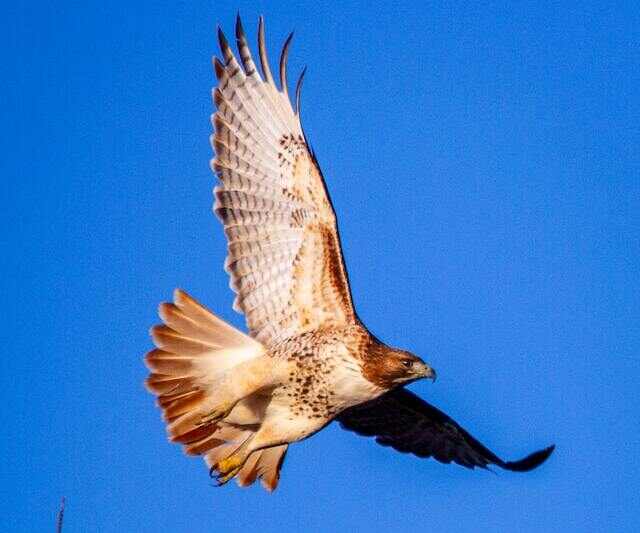
Threats to Hawk Populations
You may be interested to know that hawks face various threats that endanger their populations. Loss of habitat is a significant issue as urbanization and deforestation continue to diminish their natural habitats.
Pollution and contamination also pose a danger to these birds of prey, as they are exposed to toxins that can cause severe health issues.
Additionally, climate change affects their migration patterns and food sources, making it harder for them to survive in their changing environments.
Loss of Habitat
As the forests continue to shrink and concrete jungles grow, the majestic creatures that soar through the skies are finding it harder to call their once lush homes, now barren wastelands, their own.
Hawks, like many other wildlife species, are facing the harsh reality of habitat loss due to human encroachment.
Urbanization, deforestation, and agricultural expansion have all contributed to the fragmentation and destruction of natural habitats, leaving these birds with fewer places to nest, hunt, and thrive.
As a result, hawk populations have declined, and many species are now listed as endangered or threatened.
It’s crucial to understand the impact of habitat loss on these magnificent creatures and take action to protect their remaining habitats before it’s too late.
However, habitat loss is not the only threat hawks face. Pollution and contamination also pose significant risks to their survival, as we’ll explore in the next section.
Pollution and Contamination
If you’re not careful about the disposal of hazardous waste, it can lead to the pollution and contamination of habitats that many wildlife species, including hawks, rely on for their survival.
The effects of pollution on hawks can be devastating, as it can lead to the loss of their prey and exposure to toxic substances.
Contamination can also have a significant impact on hawk health, causing problems such as weakened immune systems, reproductive issues, and developmental abnormalities.
It’s crucial to understand that the choices we make in our daily lives can have far-reaching consequences for the environment and the creatures that call it home.
By taking steps to reduce pollution and contamination, we can help to protect the habitats that hawks and other wildlife rely on.
As we move forward, it’s essential to recognize that climate change is another significant threat to hawk populations, and we must take action to address this issue as well.
Climate Change
You already know that pollution and contamination are major threats to the survival of hawks. But there’s another factor that’s been contributing to their decline: climate change.
As temperatures rise and weather patterns become more unpredictable, hawks are finding it harder to adapt to their changing environment.
They may not be able to find enough food or water, or their breeding cycles may be disrupted. This, in turn, has a negative impact on biodiversity as a whole.
However, there are adaptation strategies that can help hawks cope with these changes, such as changing their migration patterns or finding new sources of food.
It’s important to understand the impact of climate change on these birds and take action to prevent further harm.
With that in mind, let’s delve into the importance of hawk conservation and preservation.
The Importance of Hawk Conservation and Preservation
You’ll appreciate how crucial it is to keep hawks thriving when you learn about the ways they benefit the ecosystem.
Hawks are top predators that keep the balance in nature by controlling the population of prey animals.
They also help in the dispersal of seeds by consuming fruits and dropping the undigested seeds in different places, contributing to the growth of various plant species.
Unfortunately, many hawk species are under threat due to habitat loss, hunting, and other human activities.
Conservation efforts are necessary to protect these magnificent birds and their habitats.
By supporting hawk conservation, you can help preserve the ecosystem’s health, ensure the survival of these amazing creatures, and maintain the freedom of nature.
Frequently Asked Questions
What is the lifespan of a hawk?
Hawks are fascinating birds of prey that are known for their impressive lifespan. Generally, hawks can live up to 20 years in the wild, although some have been known to live much longer.
Hawks have unique breeding and migration patterns, which vary depending on the species. For example, some hawks mate for life while others mate with multiple partners each breeding season.
Hawks are also known for their impressive migration patterns, with some species traveling thousands of miles each year to find food and breeding grounds.
If you’re interested in learning more about hawks, there are plenty of resources available that can provide you with in-depth information on these magnificent birds.
Can hawks be kept as pets?
If you’re considering keeping a hawk as a pet, there are legal restrictions you need to be aware of. Hawks are protected under the Migratory Bird Treaty Act, which means it’s illegal to possess them without a special permit.
These permits are only granted for certain purposes, such as for educational or scientific purposes.
Even if you were to obtain a permit, hawks are not suitable as pets. They’re wild animals and require specific diets, housing, and care that most people aren’t equipped to provide.
Additionally, hawks are incredibly strong and have sharp talons and beaks, which can be dangerous to handle.
It’s important to respect the laws in place to protect these magnificent birds and to understand that they’re not appropriate as pets.
What is the economic impact of hawks on local communities?
Hawks are an important part of local ecosystems, and their hunting habits can help control populations of smaller animals. However, these birds of prey have faced significant threats in recent years, including habitat loss and hunting.
As a result, there have been extensive conservation efforts to protect hawk populations and their natural habitats.
This has not only helped preserve these majestic birds but has also had positive economic impacts on local communities.
Hawk watching tourism has become increasingly popular, with birders traveling to areas where they can observe these birds in their natural habitats.
This has created opportunities for local businesses to cater to birders and has helped boost the economies of these areas.
Overall, hawk conservation efforts have had a positive impact on both the environment and local communities.
How do hawks communicate with each other?
If you’re curious about how hawks communicate with each other, you’ll be interested to know that they have distinct vocalization patterns that they use to convey various messages.
For instance, they use high-pitched squeals to communicate with their mate during breeding season, and sharp, piercing cries when they spot prey.
Hawks are also known for their hunting strategies, which vary depending on the species.
Some hawks, such as the red-tailed hawk, rely on their keen eyesight to spot prey from high above, while others, like the Cooper’s hawk, use their agility and speed to chase down prey in dense forests.
Overall, hawks have an impressive ability to communicate and hunt in the wild, making them fascinating creatures to observe and learn about.
What are the different species of hawks found in North America?
As you explore the diverse habitats of North America, you may come across various species of hawks soaring through the skies.
Each species possesses unique hunting techniques to catch their prey. These birds of prey can be found in a range of habitats, including forests, mountains, and even urban areas.
From the agile Cooper’s hawk to the majestic red-tailed hawk, hawks are truly awe-inspiring creatures. Whether cruising at high altitudes or diving to snatch prey mid-flight, they never cease to amaze.
So, if you’re someone who loves to witness the freedom of these magnificent birds, keep an eye out for the different species of hawks in your area.
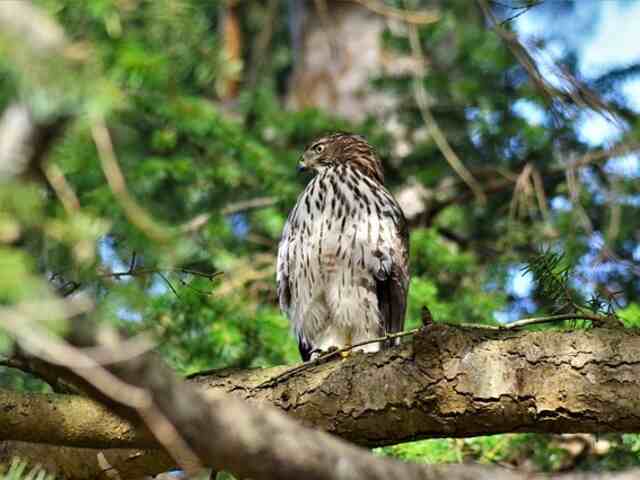
Conclusion
Congratulations, you’ve learned a lot about the protections in place for hawks! But why is it so important to protect them?
Imagine a puzzle with missing pieces – without hawks, our ecosystem is incomplete. They play a crucial role in keeping rodent populations in check, which helps to maintain balance in our environment.
Think of it like a game of Jenga. Each block represents a different species, and the removal of just one block can cause the entire tower to crumble.
Hawks are a vital block in our ecosystem, and without them, our environment could suffer irreparable damage.
So next time you see a hawk soaring through the sky, remember the crucial role they play in our ecosystem and the protections in place to keep them safe.
It’s up to all of us to do our part in preserving these magnificent birds for generations to come.

